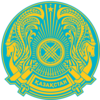تاريخ قزخستان

جزء من سلسلة عن |
||||||||||||||
|---|---|---|---|---|---|---|---|---|---|---|---|---|---|---|
| تاريخ قزخستان | ||||||||||||||
 | ||||||||||||||
| قبل التاريخ | ||||||||||||||
|
||||||||||||||
| الخانيات المبكرة | ||||||||||||||
|
||||||||||||||
| العصور الوسطى | ||||||||||||||
|
||||||||||||||
| أوائل العصر الحديث | ||||||||||||||
|
||||||||||||||
| فترة ما بعد البدوية | ||||||||||||||
|
||||||||||||||
| موضوعات | ||||||||||||||
قزخستان، أكبر بلد في سهوب أوراسيا، "ملتقى درق" تاريخي وموطن للعديد من الشعوب والدول والامبراطوريات عبر التاريخ.
استعراض
قزخستان منذ القدم كانت مأهولة بشعوب رحل. في بدايات العصر الحديث، سكنه رحل من أصول تركية - الكازاك - وهم صيادون ومربو ماشية تعتمد تقاليدهم الاجتماعية على القبلية والعشائرية والتي استمرت إلى يومنا هذا. هذه الاراضي المتصارع عليها بين الحضارتين الصينية والروسية انتهت بأحلاف وصدامات عسكرية لتحكم تحت وصاية ثم الحكم المباشر لموسكو.
أعلنت كجمهورية سوڤيتية (جمهورية القيرغيز بحدود مختلفة) في 1917، ألحقت قزخستان بـالاتحاد السوڤيتي عند نشاته. على إثر محاولات توطين السكان الرحل الذين سكنوا تاريخياً المنطقة تعرض هؤلاء لمجاعة سنوات 1931-1933. في السنوات اللاحقة لحكم ستالين اصبحت قزخستان في اطار معسكرات العمل "Steplag" مكانا لعدة عمليات تهجير خاصة بعد الحرب العالمية الثانية أحيانا أعراقاً كاملة كــتتار القرم والپولنديون والشيشان وألمان الڤولگا وآخرون.
لاحقاً أصبحت قزخستان مكانا لعدة مشاريع سوڤيتية ناجحة كـموقع تجارب سميپلاتينسك ومواقع اختباراته النووية، مركز بايكونور الفضائي وحملة الأراضي العذراء.
مع قيام البلدان السلاڤية بمحاولات تفكيك الاتحاد السوڤيتي، أعلنت قزخستان استقلالها في ديسمبر 1991. الأعوام التالية شهدت هجرات جماعية واسعة خاصة من قبل غير الكزخ الذين شعروا بالابعاد عن الأحداث الجارية؛ ولكن الوضعية الاقتصادية بدات بالاستقرار في السنوات الاخيرة، مع نمو واضح وحركة هجرة معاكسة.
رئيس الدولة الذي على رأس السلطة منذ 1990، نور سلطان نزاربييف، مازال رئيسا للبلاد وأعيد انتخابه لسبع سنوات في 2005.
في 1997، انتقلت عاصمة البلاد من ألماطي، في جنوب شرق البلاد إلى، أكمولا (أكمولسينك، تسيلونيگراد)، والتي اصبحت تسمى أستانا ("العاصمة" بالكزاخية) بهذه المناسبة، وهي مدينة تقع في السهوب شمال البلاد (أقرب إلى مركزها الجغرافي)، وهي قد تطورت كمركز حضري رئيسي لحملة الاراضي العذراء.
قبل التاريخ

القرون من الأول حتى الثامن
 مقالات مفصلة: تركستان
مقالات مفصلة: تركستان- الهجرة التوركية
القرون الثامن حتى الخامس عشر
- القرن الحادي عشر: أسلمة الاراضي الكازخستانية.
- القرن الثالث عشر: غزو جنكيز خان والمغول.
خانية القزخ (1465–1731)
- من القرن السادس عشر إلى القرن السابع عشر : غزوات قادمة من الغرب.
الامبراطورية الروسية (1731–1917)
 مقالات مفصلة: قزخستان في الامبراطورية الروسية
مقالات مفصلة: قزخستان في الامبراطورية الروسية- الاحتلال الروسي لتركستان

- 1820-1850: الالحاق بالامبراطورية الروسية.
- حوالي 1850: هجرة الفلاحين الروس.
ذاتية ألاش (1917–1920)
المجاعات (1929-1934)
الژير
وصول الأوروپيين
جمهورية قزخستان (1991–الحاضر)
عهد نزرباييڤ
- 2 مارس 1992: الانخراط في منظمة الامم المتحدة.
- مايو 1992 : اصبحت عضواً في اليونسكو.
- 27 مايو 1994: الانخراط في شراكة من اجل السلام مع الناتو.
- 30 أغسطس 1995: اعتماد دستور جديد.
- ديسمبر 1995: انتخابات تشريعية وانشاء برلمان من غرفتين.
العلاقة مع روسيا
During the mid-1990s, although Russia remained the most important sponsor of Kazakhstan in economic and national-security matters Nazarbayev supported the strengthening of the CIS. As sensitive ethnic, national-security and economic issues cooled relations with Russia during the decade, Nazarbayev cultivated relations with China, the other Central Asian nations, and the West; however, Kazakhstan remains principally dependent on Russia. The Baikonur Cosmodrome, built during the 1950s for the Soviet space program, is near Tyuratam and the city of Baikonur was built to accommodate the spaceport.
العلاقة مع الولايات المتحدة.
Kazakhstan also maintains good relations with the United States. The country is the U.S.'s 78th-largest trading partner, incurring $2.5 billion in two-way trade, and it was the first country to recognize Kazakhstan after independence. In 1994 and 1995, the U.S. worked with Kazakhstan to remove all nuclear warheads after the latter renounced its nuclear program and closed the Semipalatinsk Test Sites; the last nuclear sites and tunnels were closed by 1995. In 2010, U.S. President Barack Obama met with Nazarbayev at the Nuclear Security Summit in Washington, D.C. and discussed intensifying their strategic relationship and bilateral cooperation to increase nuclear safety, regional stability, and economic prosperity.
انظر أيضاً
- Central State Museum of Kazakhstan
- Early medieval states in Kazakhstan
- تاريخ آسيا
- تاريخ آسيا الوسطى
- تاريخ الاتحاد السوڤيتي
- نظرية الهجرة الهندو-آرية
- قائمة القزخ
- قائمة خانات القزخ
- قائمة زعماء قزخستان
- سياسة قزخستان
- الهجرة التوركية
المصادر
- Hiro, Dilip, Between Marx and Muhammad: The Changing Face of Central Asia, Harper Collins, London, 1994, pp 112–3.
- Mike Edwards: "Kazakhstan – Facing the nightmare". National Geographic, March 1993.
الهامش
- ^ "Physical Anthropology of Kazakh People and their Genesis" by O. Ismagulov & A. Ismagulova Ch., Valikhanov Institute of History and Ethnology. Almaty, Kazakhstan. In: SCIENCE - Private Fund for Supporting of Science and Technologies. Science of Central Asia, January-February 2010, No. 1.
- ^ Millward, James A. (2007), Eurasian crossroads: a history of Xinjiang, Columbia University Press, pp. 45–47, ISBN 0-231-13924-1, https://books.google.com/books?id=8FVsWq31MtMC
- ^ مراد عبد الصمدوف (2018-10-09). "تاريخ قزخستان" (in القزخية). e-history.kz.
{{cite web}}: CS1 maint: unrecognized language (link)
وصلات خارجية
- History of Kazakhstan at expat.nursat.kz
- Origins of Kazakhs and Ozbeks


